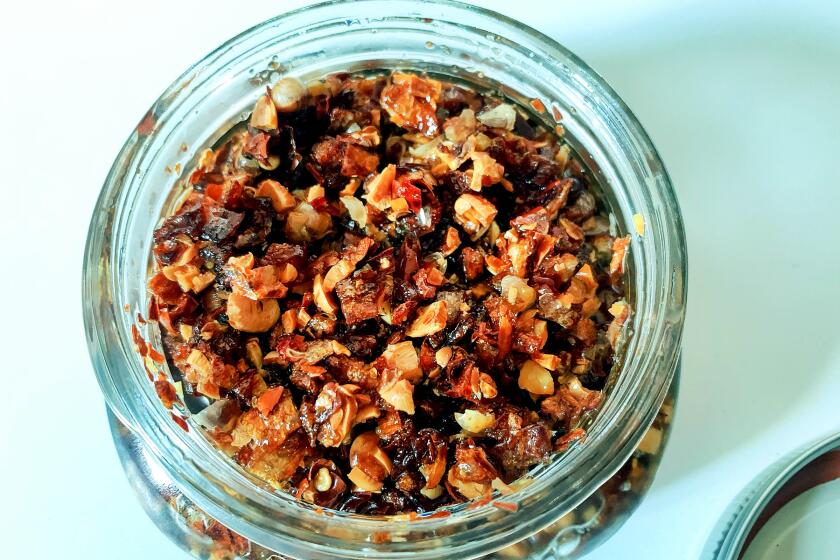Obsessed with chili crisp? Here’s how to make it extra crunchy

With so many of you having to stay home and cook for the first time — ever or more than you have in a long time — we get that it can be overwhelming to have to cook all your meals from scratch. So we’re here to get you started.
Each day we’re going to post a new skill here and go in detail about how to do it — a resource for cooking basics so you can get food on the table and get through this.
A series of simple tutorials for making some basic recipes at home.
Lesson 42: Chili Crisp
Over the last few years, food lovers in America have raved about chili crisp with the cultish fervor once devoted to Sriracha. If you haven’t tried it, imagine the salty, crackly pleasure of potato chips with a just-right amount of tingling chile heat. Those who have tasted it swoon over the savory, crunchy, oily, spiced-but-not-too-spicy condiment in the red-labeled jars from Lao Gan Ma, a Chinese sauce company.
Chili-crisp excitement has bubbled up recently stateside, but the condiment was first sold in 1997 from the Guizhou-based Lao Gan Ma company founded by Huabi Tao in 1984. And the condiment itself — countless home-cook variations of it — existed in China long before then.
I love the Lao Gan Ma sauce and thought it’d be a fun quarantine project to make a version from scratch. What makes chili crisp stand out is its texture, and I wanted to get mine as crunchy as possible.
It turns out that roasted salted soybeans — the kind you find in the healthy snack aisle — were the answer. I took a cue from the soybeans listed on Lao Gan Ma’s red label and examined all the bits in its sauce. Although peanuts work too, they aren’t as crunchy to begin with and soften over time.
Crushing the roasted soybeans into bits by hand makes them more crackly. The same is true of Sichuan peppercorns, which give the sauce the lip-numbing tingle characteristic of southwestern Chinese cuisine. When I tried pulsing them in a spice grinder and food processor, they turned into powder, which was tasty but not texturally satisfying.
The other key to keeping the condiment crisp is eliminating liquid in the mix. When you have only dry ingredients in oil, nothing gets soggy. To achieve that, the fresh onion needs to simmer in oil slowly over low heat so its water evaporates. I also season the onion with salt and sugar while it cooks to heighten its natural sweetness and enhance its crunch. Once fried, the onion needs to cool completely to maximize its crispness.
Instead of stirring soy sauce into the jarred mix, I add it to whatever dish I’m spooning chili crisp all over. To capture the signature hot-sour-salty-sweet balance of Guizhou dishes, especially noodles, I often toss in vinegar as well. And when I’m using it in other meals — fried or scrambled eggs, roasted vegetables, seared salmon — I find it goes great with everything.
Extra Crunchy Chili Crisp
More to Read
Eat your way across L.A.
Get our weekly Tasting Notes newsletter for reviews, news and more.
You may occasionally receive promotional content from the Los Angeles Times.













